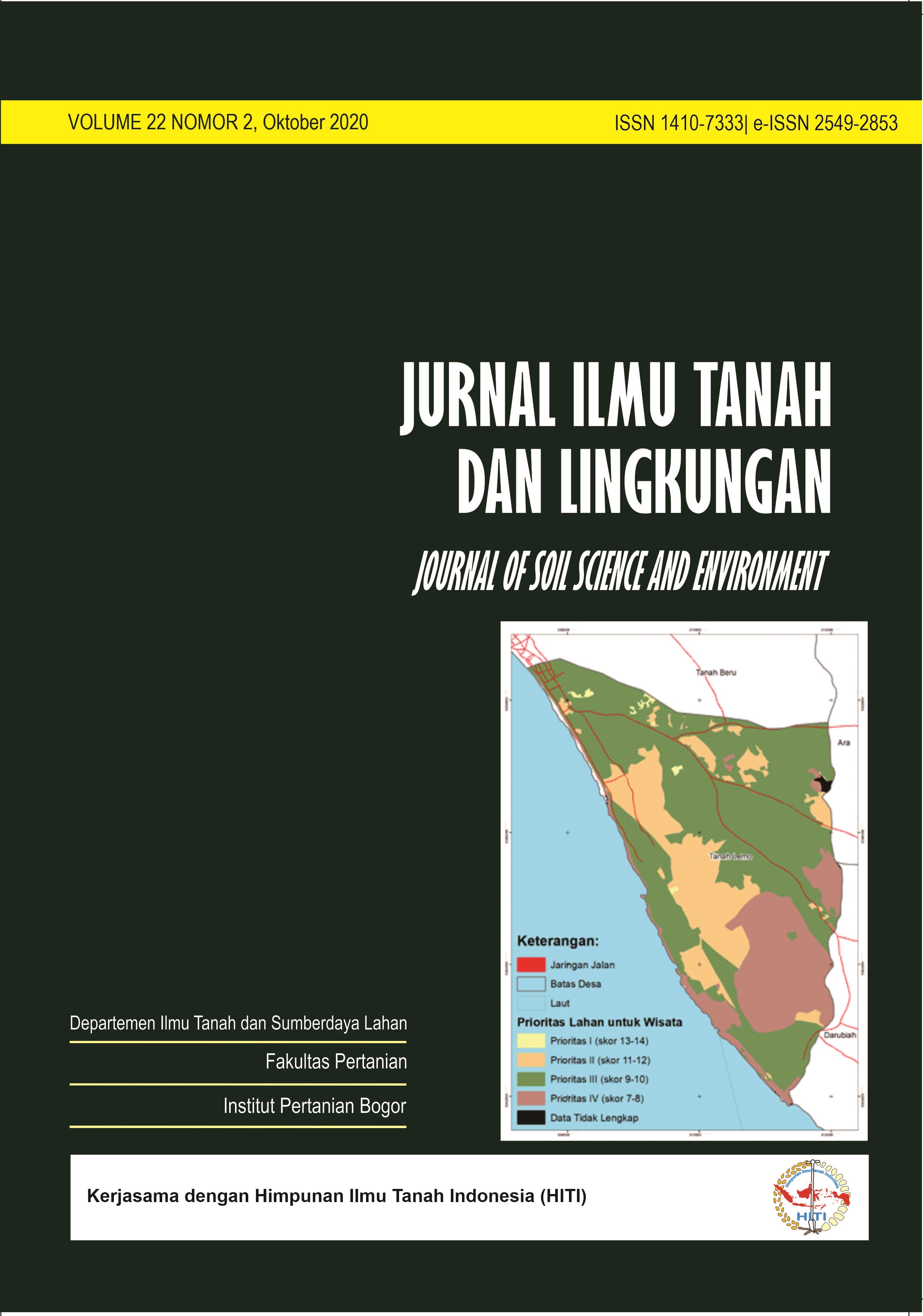Tourism Area Planning Based on Issues and Local Potency in Tanah Lemo Village, Bontobahari District, Bulukumba Regency, South Sulawesi Province
Perencanaan Areal Pariwisata Berdasarkan Isu dan Potensi Lokal di Desa Tanah Lemo, Kecamatan Bontobahari, Kabupaten Bulukumba, Provinsi Sulawesi Selatan
Abstract
The tourism sector is one of the main sectors in Bulukumba Regency. Based on the Spatial Planning (RTRW) of Bulukumba Regency in 2018-2038, Tanah Lemo Village is one of the areas planned for the development of tourism destinations. One of the undeveloped tourism potentials in Tanah Lemo Village is Lemo-Lemo Beach. This study aims to identify land use in 2019, analyze landrent per land use, determine land priorities for tourism development, and identify strategies for developing Lemo-Lemo Beach Tourism. The data used are google earth imagery, spatial pattern maps, parcel maps, parcels of land, degraded land, agricultural direction, slope and so forth, as well as the results of interview respondents. The methods used in this study are visual interpretation and classification of land cover (GIS), landrent analysis, determination of the priority level of land for tourism development, and SWOT analysis. The results showed that there were 11 types of land use in the study location were water bodies, ponds, emplacement, high density forests, low density forests, mixed gardens, open land, high density settlements, medium density settlements, shrubs and fields. The largest land use is moor. The largest landrent value is high density settlements of Rp. 150,458 / m2 / year. Based on the priority level of land for the development of tourist areas, priority I is 49 ha (1.7%), while the most extensive is priority III (54%). The strategy of developing Lemo-Lemo Beach tourism is by promoting tourism promotion, including by hosting local or national tourism festival activities, developing spring tourism, community forest parks, cultural sites and developing alternative tourism options, for example playgrounds / outbound and others so. Tanah Lemo Village has the potential for the development of tourism in the future.
Downloads
References
Agustina, A., M.S. Madjid dan Jumadi. 2018. Objek wisata pantai Lemo-Lemo di Kabupaten Bulukumba 2000-2015. J. Pattingalloang, 5(1): 111-120.
Almeida, J.C, F. Costa and N. da Silva. 2017. A framework for conflict analysis in spatial planning for tourism. Tourism Management Perpsectives, 24:94-106. https://doi.org/10.1016/j.tmp.2017.07.021
Ante, E, N.M. Benu dan V.R.B. Moniaga. 2016. Dampak ekonomi dan sosial alih fungsi lahan pertanian hortikultura menjadi kawasan wisata Bukit Rurukan di Kecamatan Tomohon Timur, Kota Tomohon. Agri-Sosio Ekonomi, 12(3):113-124.
Baharuddin, L. M.R. Bochari dan Firmansyah. 2019. Pengembangan Kawasan Tanah Lemo dan Ara sebagai Pusat Industri Kerajinan Miniatur Kapal Phinisi di Kecamatan Bontobahari, Kabupaten Bulukumba. J. Teknologi Terapan untuk Pengabdian Masyarakat, 1(2): 1-7.
Blancas, F.J, M.L. Oyola, M. Gonzales, F.M. Guerrero and R. Caballero. 2011. How to use sustainability indicators for tourism planning: The case of rural tourism in Andaluasia (Spain). Science of The Total Environment, 412-413: 28-45. https://doi.org/10.1016/j.scitotenv.2011.09.066
Chiappa, G, D.M. Atzeni and V. Ghasemi. 2018. Community-based collaborative tourism planning in islands: A cluster analysis in the context of Costa Smeralda. J. of Destination Marketing and Management, 8: 41-48. https://doi.org/10.1016/j.jdmm.2016.10.005
Czyżewski, B. and A. Matuszczak. 2016. A new land rent theory for sustainable agriculture. Land Use Policy, 55(2016): 222–229. https://sci-hub.ren/10.1016/j.landusepol.2016.04.002
Jager, J. 2020. Land Rent Theory. International Encyclopedia of Human Geography (Second Edition). Pg 93-98. https://doi.org/10.1016/B978-0-08-102295-5.10666-3
Kantola. S, M. Uusitalo, V. Nivala and S. Tuulentie. 2018. Tourism resort users’ participation in planning: Testing the public participation geographic information system method in Levi, Finnish Lapland. Tourism Management Perspectives, 27: 22-32. https://doi.org/10.1016/j.tmp.2018.04.001.
Lai, K, Y. Li and X. Feng. 2006. Gap between tourism planning and implementation: A case of China. Tourism Management, 27:1171-1180. doi: 10.1016/j.tourman.2005.11.009
Lillesand, T.M., W. Kiefer and J.W. Chipman. 2004. Remote Sensing and Image Interpretation (Fifth Edition). John Wiley & Sons, Inc., New Work.
Liu, A. and G. Wall. 2006. Planning tourism employment: a developing country perspective. Tourism Management, 27(1): 159-170. https://doi.org/10.1016/j.tourman.2004.08.004
LPEM UI - Lembaga Penyelidikan Ekonomi dan Masyarakat Fakultas Ekonomi dan Bisnis Universitas Indonesia. 2018. Laporan Akhir Kajian Dampak Sektor Pariwisata Terhadap Perekonomian Indonesia. Universitas Indonesia. Jakarta
Mai, T. and C. Smith. 2018. Scenario-based planning for tourism development using system dynamic modelling: A case study of Cat Ba Island, Vietnam. Tourism Management, 68: 336-354. https://doi.org/10.1016/j.tourman.2018.04.005.
Maguidad, V.M. 2013. Tourism planning in archipelagic Phillippines: A case review. Tourism Management Perspectives, 7: 25-33. https://doi.org/10.1016/j.tmp.2013.03.003
Mulya, S.P., E. Rustiadi dan A.E. Pravitasari. 2019. Perbandingan land rent pertanian dan non pertanian di Kabupaten Bogor dan Kota Bogor. Prosiding Seminar Nasional Asosiasi Sekolah Perencanaan Indonesia (ASPI) 2019. Hal 513-517. 3 Oktober 2019. Universitas Tanjungpura, Pontianak.
Oyola, M.L., F.J. Blancas, M. Gonzales and R. Caballero. 2012. Sustainable tourism indicators as planning tools in cultural destinations. Ecological Indicators, 18: 659-675. https://doi.org/10.1016/j.ecolind.2012.01.014
Papageorgiou, M. 2016. Coastal and marine tourism: A challenging factor in marine spatial planning. Ocean and Coastal Management, 129: 44-48. https://doi.org/10.1016/j.ocecoaman.2016.05.006.
Rahmafitria, F., P.L. Pearce, H. Oktadiana and H.P.H. Putro. 2020. Tourism planning and planning theory: Historical roots and contemporary aligment. Tourism Management Perspectives, Vol 35. https://doi.org/10.1016/j.tmp.2020.100703.
Rangkuti, F. 2011. SWOT Balanced Scorecard Teknik Menyusun Strategi Korporat Yang Efektif Plus Cara Mengelola Kinerja dan Risiko. PT. Gramedia Pustaka Utama, Jakarta.
Supriatna, J. Supriatna, R.H. Koestoer and N.D. Takarina. 2016. Spatial dynamics model for sustainability landscape in Cimandiri Estuary, West Java, Indonesia. Procedia-Social and Behavioural Sciences, 227: 19-30. doi: 10.1016/j.sbspro.2016.06.038.
Sutanto. 1981. Aplikasi Penginderaan Jauh Untuk Dalam Perencanaan Kota. Fakultas Geografi UGM, Yogyakarta.
Yulianda, F., A. Fahrudin, A. Hutabarat, A. Armin, H. Sri, K. Kusharjani dan H. Sang. 2010. Pengelolaan Pesisir dan Laut Secara Terpadu. Book 3. Pusdiklat Kehutanan-Departemen Kehutanan RISECEM- Korea International Coorporation Agency, Bogor.
Department of Soil Science and Land Resources Departemen Ilmu Tanah dan Sumberdaya Lahan, Faculty of Agriculture Fakultas Pertanian, IPB University



















